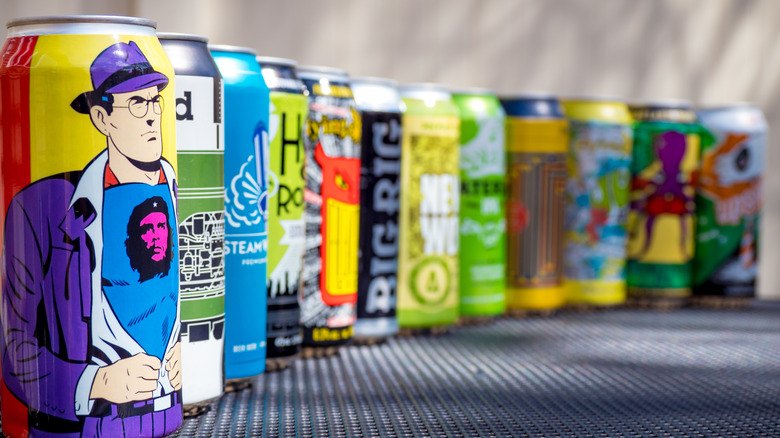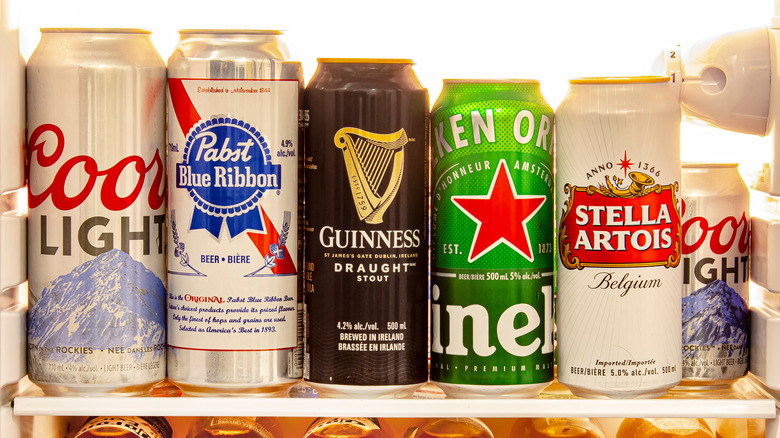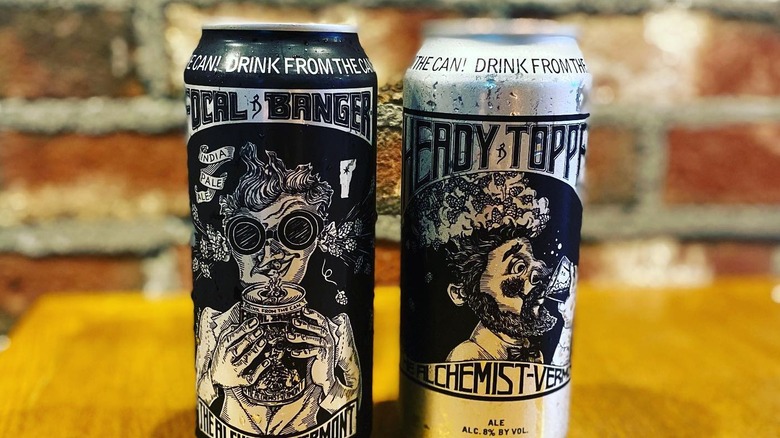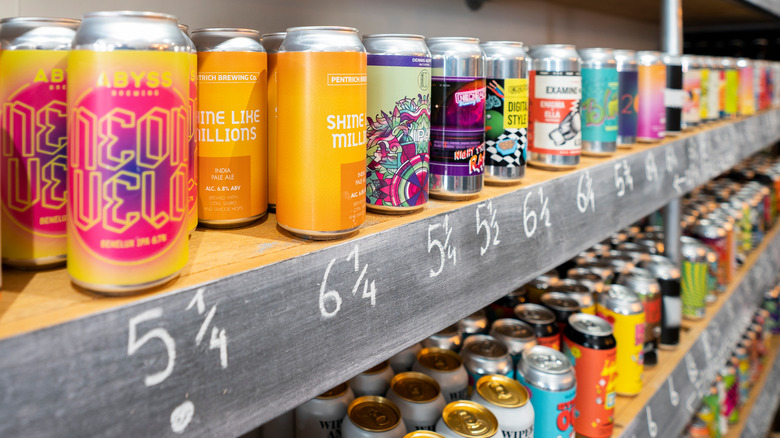The Reason Craft Beers Seem To Always Come In 16 Ounce Cans
Large, 16-ounce beer cans have become something of an unofficial industry standard for craft breweries in the past decade. In both taprooms and on store shelves, it's common to see four-packs of these cans as take-home options for customers. There are many reasons why producers make this choice, one of which being that bigger cans are more cost-effective for smaller companies, thanks to the reduced amount of packaging compared to a typical six-pack of 12-ounce cans. However, due to their larger size (and the extra money you pay for a unique beer), brewers can sell their packs at a comparable price point.
This money-saving move allows more resources to be spent on developing beer recipes themselves, instead of on production. Things weren't always this way, though. When the craft brewing craze was in its infancy, smaller independent breweries stuck almost exclusively to bottling their beer. They were eager to set themselves apart from the masses, so craft brewers shunned the appearance of "cheap" cans for something that felt a bit more classy.
However, as the craft beer revolution in the U.S. took off, brewers turned to canning as a means to make their products more widely available and easier to distribute. The size of the can, whether sold separately or in the customary four-packs, is intended to communicate quality and distinguish craft creations as premium products.
Big-scale breweries once dominated the big can market
Craft breweries aren't the only ones that favor this style of can. There was a time when shelves of single, 16-ounce grab-and-go beers were used almost exclusively by big-name brands. Large domestic breweries stocked corner store shelves with these cans for decades. They were popular with customers due to their appealing size, and favored by producers for their aforementioned affordability. These colloquially-nicknamed "tallboy" cans have long been a go-to choice for customers looking for a convenient drink, one that satisfies them with just one serving.
Since the mid-2010s, more and more craft beer brands began selling their own tallboys at sports stadiums, concert venues, and convenience stores. Tapping into the single-serve market has allowed craft breweries to extend their reach dramatically, especially to curious consumers who enjoy the ease of a full pint to-go. No matter which brand produces them, 16-ounce cans offer an easy quick-pick option from a store's cooler, and customers can get more beer than a standard 12-ounce can without committing to a six- or 12-pack. The advantages of offering this style of packaging are clear, and two brands in particular are responsible for enlightening their craft brew brethren.
Oskar Blues and Alchemist Brewing bolstered the can trend
Oskar Blues Brewery in Colorado got into the canned craft beer game ahead of most other brands. In 2002, a spam marketing fax was sent to the company's office advertising can seamers (a tool for sealing lids), so it opted to try canning its beer. For Colorado's avid outdoor community, cans were safer and more practical to carry than glass bottles. It would take a few more years before the craft can craze kicked off, but Oskar Blues was on the trail.
Vermont-based brewery The Alchemist was another early adopter of 16-ounce cans, and is widely credited with popularizing the style among craft breweries. Back in 2011, its game-changing hazy IPA called Heady Topper hit shelves in an artsy black and silver can. The company sought to make its beer more appealing and unpretentious, while reaping the economic values of cheaper aluminum packaging. Other brands followed suit once the demand for canned craft brews became clear, and a marketplace trend was born.
Alchemist co-owner and brewer John Kimmich also extolls the benefits of drinking beer straight from the can, promoting it as an easy way to preserve flavor. And he's not wrong: Cans are better for preserving beer's freshness (yes, you should actually check beer expiration dates!) since they protect it from damaging sunlight and oxygen. Cans are also easier to pack, ship, and store, thanks to their comparatively lighter weight. That's a win for both breweries and customers.
Why craft beer cans are marked by art and individuality
Once upon a time, tall cans (or cans in general) could help a craft beer stand out, but now that it's become the standard, breweries must find creative, expressive ways to differentiate their products. Distinct, quirky labels have become a popular solution. Craft beer packaging design is usually recognizable for its eye-catching colors and graphics, with breweries taking advantage of all that spacious aluminum real estate to create unique, art-adorned cans that pull in curious drinkers. It helps that a tallboy can has so much space for all these graphics (plus info about the beer itself).
Breweries often contract artists to create on-brand artwork for their unique beverages. Beyond advertising, creative labels are a means of promoting and communicating brand identity. And it's effective — over 50% of surveyed American craft beer consumers cited labels as key factors in grabbing their attention (via Toky). For a majority of these same buyers, a cool package design also impacts their purchase choices.
All these factors prove the efficacy of the marketing trends that have come to dominate craft beer culture. Though 16-ounce cans have become a common sight, breweries are maintaining their individuality by continuing to tap into the creative, pioneering spirit that fueled the industry from the start.




